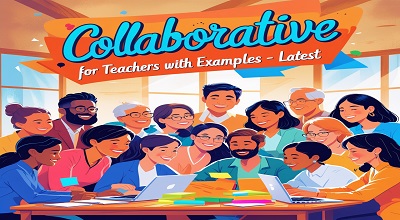Collaborative Learning for Teachers
Collaborative Learning for Teachers: Collaborative learning is an educational approach where teachers work together to share knowledge, strategies, and resources to improve teaching practices and student outcomes. Unlike traditional isolated teaching methods, collaborative learning fosters a culture of teamwork, continuous professional development, and peer support.
In today’s rapidly evolving educational landscape, teachers must adapt to new pedagogical approaches, technology integration, and diverse student needs. Collaborative learning empowers educators to learn from each other, refine their teaching techniques, and create more engaging classroom experiences.
This website explores the latest trends, strategies, and real-world examples of collaborative learning for teachers, helping educators enhance their professional growth.
Why Collaborative Learning is Essential for Teachers?
Collaborative learning is no longer optional—it’s a necessity for modern educators. Here’s why:
- Professional Growth: Teachers gain new insights and skills by learning from colleagues.
- Improved Student Outcomes: Shared best practices lead to better teaching methods.
- Innovation in Teaching: Collaboration encourages creative lesson planning.
- Emotional Support: Reduces teacher burnout by fostering a supportive community.
- Adaptation to Change: Helps educators stay updated with new technologies and trends.
Schools that prioritize teacher collaboration see higher engagement, retention, and academic success.
Key Benefits of Collaborative Learning for Educators
A. Enhanced Teaching Strategies
Teachers exchange lesson plans, classroom management techniques, and assessment methods.
B. Increased Motivation and Job Satisfaction
Working in teams reduces isolation and boosts morale.
C. Better Problem-Solving
Collaborative discussions help address classroom challenges effectively.
D. Personalized Learning Approaches
Teachers tailor instruction based on shared experiences and student data.
E. Continuous Professional Development (CPD)
Ongoing learning through workshops, peer observations, and feedback loops.
Effective Strategies for Collaborative Learning Among Teachers
A. Professional Learning Communities (PLCs)
PLCs are structured groups where teachers meet regularly to discuss curriculum, student performance, and teaching strategies.
B. Peer Observations and Feedback
Teachers observe each other’s classes and provide constructive feedback.
C. Co-Teaching and Team Teaching
Two or more educators collaborate to deliver lessons, combining their expertise.
D. Online Collaboration Platforms
Tools like Google Workspace, Microsoft Teams, and Slack facilitate virtual teacher collaboration.
E. Workshops and Training Sessions
Schools organize training programs where teachers learn new skills together.
Real-World Examples of Collaborative Learning in Schools
1: Lesson Study in Japan
Japanese teachers collaboratively plan, observe, and refine lessons to improve instruction.
2: Flipped Staff Meetings in the U.S.
Instead of traditional meetings, teachers discuss pre-recorded training videos and share insights.
3: Cross-Departmental Collaboration in the UK
Math and science teachers work together to integrate STEM concepts.
4: Global Teacher Networks
Platforms like Edmodo and Twitter (#EdChat) connect educators worldwide.
Technology Tools to Enhance Teacher Collaboration
| Tool | Purpose |
|---|---|
| Google Classroom | Shared lesson planning & assignments |
| Padlet | Virtual brainstorming & idea sharing |
| Zoom | Virtual meetings & webinars |
| Trello | Project management for teacher teams |
| Flipgrid | Video discussions & feedback |
Challenges and Solutions in Implementing Collaborative Learning
1: Time Constraints
Solution: Schedule short, focused collaboration sessions.
2: Resistance to Change
Solution: Foster a culture of openness and mutual respect.
3: Lack of Administrative Support
Solution: Present data on how collaboration improves outcomes.
Future Trends in Teacher Collaboration
- AI-powered teacher assistants for personalized PD
- Virtual reality (VR) for immersive collaborative training
- Global teacher mentorship programs
FAQs About Collaborative Learning for Teachers
Q1: What is the best way to start collaborative learning among teachers?
A: Begin with small PLCs or peer observation programs.
Q2: How does collaborative learning improve student performance?
A: Teachers refine strategies based on shared insights, leading to better instruction.
Q3: What are some free tools for teacher collaboration?
A: Google Docs, Slack (free tier), and Microsoft Teams (basic version).
Q4: Can introverted teachers benefit from collaboration?
A: Yes! Online forums and written feedback can be less intimidating.
Q5: How often should teachers collaborate?
A: At least once a week for meaningful impact.
Conclusion
Collaborative learning transforms teaching from an isolated profession into a dynamic, team-based effort. By leveraging strategies like PLCs, co-teaching, and digital tools, educators can enhance their skills, boost student success, and stay ahead in the evolving education sector.
Free Download Link: TEKKEN™ APK
